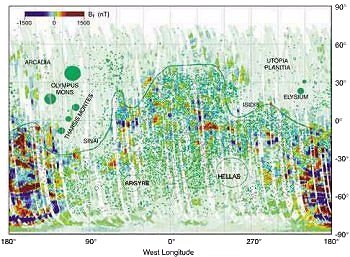Martian Interior
Inside Mars
Is the core liquid or solid?
"The only thing we know for sure about the interior of Mars is that it has a core with a radius of between 1500 and 2100 km," says Christophe Sotin, a planetary geophysicist at the University of Nantes, France. Such certainty has come from measurements of the planet's moment of inertia taken by the NASA spacecraft, Mars Pathfinder. The moment of inertia is a measure of the way in which the planet rotates on its axis, which is influenced by the distribution of material within it. "The measurements reveal that there is something dense in the centre and less dense in the outer layers," says Sotin.
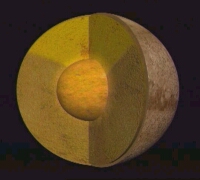 |
|
Model of possible core structure of Mars (NASA - Goddard Space Flight Center) |
The Martian interior is one of the big unknowns to be addressed by future missions to Mars. Understanding its structure is important because it will contribute towards an understanding of the formation of the atmosphere, the fate of life on Mars and ultimately planetary evolution, including the evolution of Earth. "The evolution of the interior of the planet affects the evolution of the surface and so drives the loss of ecological niches for life on the surface," explains David Stevenson, professor of planetary science at the California Institute of Technology. "Everything about the interior of Mars is uncertain because we lack seismological information. That is the most important goal for a future mission."
Seismic probes
The French space agency, CNES, is planning to build four small probes, called Netlanders, to address that goal. They will hitch a ride to Mars on board a French-built orbiter and will land at widely spaced sites. "On each Netlander will be a seismometer to detect Mars quakes," says Sotin. "The quakes are caused when the planet shrinks as it cools. We expect about 1000 quakes a year of magnitude three on the Richter scale and two of magnitude five. The four seismometers will be able to deduce where the quake occurred. As the seismic waves are going to travel through the planet, we can also determine changes in the composition of the material they are travelling through."
As well as measuring the radius of the core to within 5 km, seismic data will also reveal what the core is made from and whether it is liquid or solid. The moment of inertia measurements suggest it is made predominantly from iron, like the Earth's core. But it may also include some sulphur, which will lower its density and melting point. Earth's liquid core is responsible for our planet's magnetic field: the circulating molten metal acts as a dynamo. Mars has no magnetic field nowadays, though it did once in the past. However, this doesn't necessarily mean that its core is solid. "From a theoretical standpoint, the core can't be entirely solid, but it could have a solid inner core, like the Earth's," says Stevenson.
Clues on the surface
Other clues to the Martian interior can be found by looking at the planet's surface. "We know the crust is an average of 50 km thick - we don't see craters that have punched down below the crust to the mantle. This is thicker than the Earth's crust, which isn't surprising" says Stevenson. As Mars is smaller than Earth but of a similar age, its outer layers have cooled and solidified to a greater depth than Earth's. However, the crust is far from uniform in thickness, with the crust in the south of the planet being thicker and older than that in the north.
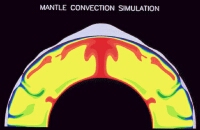 |
|
Computer simulation of processes in the interior of Mars that could have produced the Tharsis region (Walter S. Kiefer and Amanda Kubala, LPI) |
The great volcanoes indicate that underneath the crust is a mantle which is at least partially molten and from which hot plumes rise to the surface. "The volcanoes suggest convection in the mantle, but we don't know their precise source," says Sotin. The crust also bears scars of previous tectonic activity, such as the Tharsis bulge, where forces underneath the planet's crust have shaped it. But there's no evidence for plate tectonics, the process on Earth by which new crust is formed at seafloor spreading regions and old crust is swallowed back into the mantle at subduction zones. The lack of recycling is thought to explain why the Martian volcanoes have grown so large: movements in the planet's crust have simply never disturbed them.
Evidence from meteorites
The tenuous evidence we have so far for the composition of the mantle has come, paradoxically, from a handful of rocks found on Earth. Tiny pockets of gas trapped inside the rocks have the same composition as the Martian atmosphere, suggesting that they originated on the red planet. They eventually found their way to Earth millions of years after being blasted off the Martian surface by major impacts. The rocks, known as SNC meteorites, are volcanic in origin and are thought to have welled up from the Martian mantle in the form of magma that then crystallised near the surface. Deducing the composition of the mantle from that of the meteorites, however, is no straightforward matter. The latest attempts suggest that the mantle has a similar composition to that of the Earth, but with a higher iron content.
|
|
|
Martian meteorite ALH84001 |
"From measurements on seismic waves, we will be able to put some constraints on the chemical composition of the core and mantle," says Sotin. The main contribution Mars Express will make to this area is in a better understanding of the composition of the crust (PFS, OMEGA, MARSIS).
Paleomagnetism
Mars no longer has a significant global magnetic field. But we now know that it had one early in its history. Observations by NASA's Mars Global Surveyor (MGS) spacecraft have revealed the tell-tale signs in the ancient crust of the southern hemisphere: stripes of magnetised crust of alternating polarity running roughly parallel for 2000 km.
The strength and structure of the magnetism has taken planetary geologists by surprise. Similar stripes discovered on the Earth's seafloor in the 1960s were pivotal in gaining acceptance for the theory of plate tectonics. Do the new findings mean that plate tectonics also operated on early Mars? Until now, the MGS data geologists thought it hadn't, but now they're not so sure.
|
|
|
A map of Mars showing blue and red stripes of alternating polarity |
A benefit from misfortune
The discovery was made thanks to a couple of unfortunate incidents which resulted in MGS going closer to the Martian surface than originally intended. The size and significance of the magnetic stripes probably wouldn't have been appreciated from a greater observing height.
"After the loss of the Mars Observer spacecraft in 1993, NASA decided to build a new mission, MGS, that was cheaper, faster and better. To make the spacecraft cheaper, we needed to save weight and fuel," explains Henri Rème from the Centre d'Etudes Spatiales des Rayonnements, Toulouse, France, who is an investigator on the MGS magnetometer instrument. Mars Observer had a powerful on-board engine to inject it into the correct circular orbit. With MGS, it was decided to save weight by using a smaller engine and the friction of the atmosphere to nudge the spacecraft gradually into its final orbit.
During this aerobraking phase, part of the MGS orbit was just over 100 km above the Martian surface, closer than the 350 km height of MGS' final orbit or that planned for Mars Observer. For a few orbits, the close passes revealed disjointed areas of magnetism in the crust. "Then the second bad thing happened that was good for us," says Reme. "The arm of one of the solar panels wasn't standing up well to the friction, so NASA decided to take the aerobraking process more slowly. Aerobraking would normally take three months, but it was decided to have a long phase lasting 15 months. That meant there were a lot of low altitude passes."
A pattern emerges
Gradually a pattern began to emerge from the magnetometer data. 100 km wide stripes of magnetised crust running roughly parallel for up to 2000 km, were revealed in the southern hemisphere. The stripes alternate in polarity with the north magnetic pole of one pointing up from the surface and the north magnetic pole of the next pointing down.
"About 12 of us were sitting round a table at the Jet Propulsion Laboratory in Pasadena, California before the first low altitude pass," says Rème. "We decided to place a bet on the size of the magnetic field. Our predictions ranged from 5-100 nT. At the first pass, MGS recorded a value of 55 nT. Two days later it recorded 400 nT, which was a complete surprise. But when the spacecraft went above the southern hemisphere, the surprise was fantastic. We obtained 1600 nT."
When molten rock containing magnetic material, such as haematite (Fe2O3), cools and solidifies in the presence of a magnetic field, it becomes magnetised and takes on the polarity of the background field. This magnetism is lost only if the rock is subsequently heated above a particular temperature (the Curie point which is 770oC for iron). The magnetism left in rocks is therefore a record of the magnetic field prevailing when the rock solidified.
An ancient magnetic field
Most of the rock in the southern hemisphere of Mars solidified about 4 billion years ago. Younger rock, or old rock that has been subsequently re-heated (by impacts for example), shows no magnetism. This indicates that the global field lasted for only the first few hundred million years of Mars' life, when the temperature of the molten iron in the planet's core might have been high enough to churn it into a magnetic dynamo. "Why did the Martian magnetic field disappear? We need to know," asks Rème.
The stripes suggest that the field changed polarity in a similar way to the Earth's magnetic field - several times per million years, but not regularly. When similar stripes were discovered on Earth in the 1960s, they were taken as evidence of plate tectonics, the process by which vast slabs of the Earth's crust gradually move over underlying magma. The stripes were found in the ocean floor, spreading out from either side of underwater vents in the crust where magma wells up continuously to form new seafloor that gradually pushes the continents apart.
There are some differences, however, between the magnetic stripes on Earth and those on Mars. The Martian stripes are wider, much more strongly magnetised and do not appear to spread out from a central crustal spreading zone. "There is not enough data to know for sure whether there was plate tectonics or not," says Rème, who is now involved in planning a micromission to collect more data. "Geologists think plate tectonics never existed on Mars. But we now know it's a possibility."
Volcanism
Forces that shape the Martian surface
 |
|
Olympus Mons, a gentle giant (NASA MGS) |
Olympus Mons, the largest volcano in the solar system, is of truly gargantuan proportions. Not only is it 27 km high, more than three times the height of Mount Everest, it is also 550 km in diameter and is rimmed by a 6 km high escarpment. Once over this ridge, the first humans to climb it will have a very long, but gentle climb: its slope is only 2-5o.
Olympus Mons lies off the north-west flank of the Tharsis region, a bulge in the Martian crust 4000 km wide and 10 km high. Situated on the rise are three more volcanic giants: Ascraeus Mons, Pavonis Mons and Arsia Mons. Elysium Planitia, another, smaller area of high ground, also boasts large volcanoes, although not as large as those associated with Tharsis. They are Hecates Tholus, Elysium Mons and Albor Tholus.
Up-welling mantle
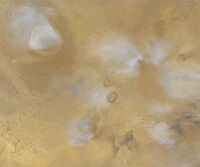 |
|
Water vapour around peaks of the Tharsis volcanoes |
The Tharsis and Elysium bulges are deformations in the Martian crust caused by pressure in the underlying mantle. The volcanoes formed where the up-welling mantle pushed holes into the overlying crust. The regions are the youngest on Mars: the tectonic processes that shaped them switched off last.
Volcanism probably began on Mars about 4.2 billion years ago, just a few hundred million years after the planet's birth and shortly after the end of heavy bombardment by the numerous planetismals that populated the solar system at the time. The impacts left huge craters, such as the Hellas Basin, with highly fractured floors. "We believe that volcanism came to the surface through these fractures," says Philippe Masson, from the Laboratoire de Giologie Dynamique de la Terre et des Planètes, Orsay, France.
Evidence for that early volcanism still exists in the ancient rocks of the southern hemisphere, which have been undisturbed by major tectonic activity ever since. "Volcanic activity was global in the beginning, then it retreated to the north where it went on for while. Finally it retreated to Tharsis where we think it stopped," says Tilman Spohn, from the Universität Münster, Germany.
Nobody knows why major tectonic activity and volcanism switched off around the planet in this way, in particular why Tharsis and Elysium ended up as the only areas of tectonic activity. However, it's not surprising that the bulges should be associated with large volcanoes. "As Tharsis pushed up, it split the crust. The three volcanoes on the dome are aligned - they're probably all on the same underground fault," says Masson.
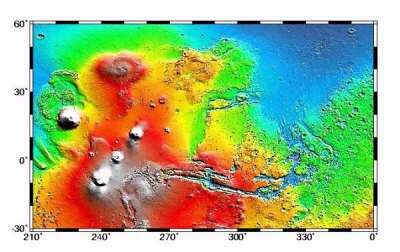 |
|
Regional map of the Tharsis dome (high elevation to the west) and Chryse outflow basin (low lying region to the east) (MOLA Science Team) |
Split in the crust
The raising of the Tharsis dome is also linked to another remarkable Martian feature, the Valles Marineris, a deep gash in the crust which runs east-west for almost a fifth of the planet's circumference. It dominates images of the red planet taken from the right side. "In high resolution images, we can see that faults associated with the Tharsis dome played a role in the formation of the canyon. However, erosional processes due to landslides and water took place at different times and contributed to the enlargement of the canyon," says Masson.
Why did the Martian volcanoes grow so big? The answer, most are agreed, is because Mars is a one plate planet - or at least it has been since early in its history. This makes it quite different from the Earth whose crust is fractured into several discrete plates which move in relation to each other by floating on underlying molten mantle. The size of Earth's volcanoes is limited because the crust eventually moves away from mantle hotspots. On Mars, the same crust has remained above the hotspots for billions of years, allowing volcanoes to grow and grow.
Mars may still be volcanically active
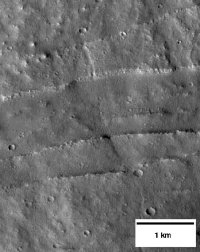 |
|
Region near Arsia Mons showing low crater counts |
Is Mars volcanically dead - or could one of the Tharsis or Elysium volcanoes surprise us yet? Recent evidence from Mars Global Surveyor (MGS) data suggests that perhaps they could.
William Hartmann from the Planetary Science Institute in Tucson, Arizona, Alfred McEwen from the University of Arizona and their team of US collaborators have used images from the MGS camera to estimate that lava flows south of Elysium Mons are a mere 20 million years old. "Some individual flow units could be as young as 10 million years or less", says Hartmann. "In geological terms, that's so recent that volcanic activity might start up again at any time somewhere on the red planet."
The clue lies with crater counts
They came to this conclusion after counting the number of impact craters of various sizes on the lava flows. The older a surface, the more impact craters it will have because it has been around longer to accumulate them. This dating method, however, is uncertain by a factor of up to four and the team's results have yet to gain universal acceptance.
"If I tell you I have an area with an age of 20 million years and I'm out by a factor of four, then the true age could be as much as 80 million years. But that's still within the last few per cent of Martian history," points out Hartmann. "This means volcanism did not shut off in the first 2.5 billion years, as some early scientific papers proposed. Rather, the planet apparently continues to have at least some localised, sporadic activity."
The team have also found evidence for flows less than 100 million years old on the slopes of Olympus Mons and Arsia Mons, one of the Tharsis volcanoes. But the accuracy of these dates will probably not be known for sure until a lander capable of providing absolute ages of rocks in situ, or a sample return mission, heads for one of the areas in question.


